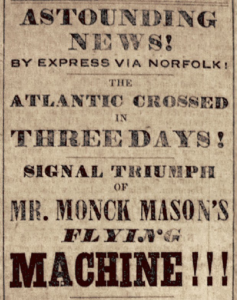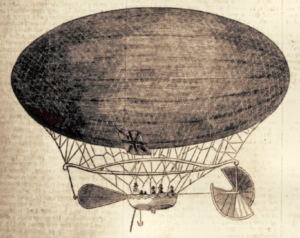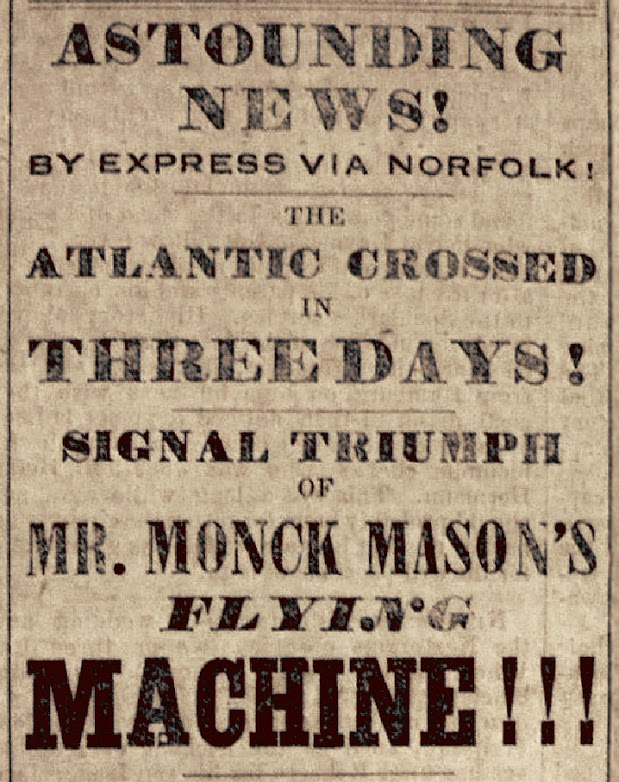This article is an excerpt from Murray Ellison’s VCU MA Thesis on Poe and Nineteenth-Century Science, ©2015
Near the end of his journalistic career, Poe was likely running out of actual science reports to write about that would excite the public’s interest in science as spectacularly as his fictional stories did. Perhaps, by that time, his imagination far exceeded science’s ability to create new inventions. His 1843 “Balloon Hoax” story demonstrated that sensational quasi-scientific newspaper reports could command the public’s attention in ways that even he could have never imagined. By presenting a fictional narrative as if it was an actual front-page news story, Poe captured the attention of a larger segment of nineteenth-century readers than he did in any of his previous journalistic reports. However, this move also seriously damaged his credibility as a serious science reporter. Poe, in this account, also introduced a more skeptical attitude concerning nineteenth-century science than he displayed in his previous journalistic outputs. Therefore, his “Hoax” is a transitional story linking his earlier journalistic writing to his later fictional science narratives.
The extraordinary story of a Transatlantic Balloon crossing was first written by Poe under the pseudonym of John Wise, and was first published in the June 15, 1843, issue of the newspaper, Spirit of the Times, which reported that a “well-known balloonist plans to take a trip across the Atlantic Ocean in the summer of 1844” (Thomas and Jackson 414). A year after, The New York Sun ran a follow-up news report on the balloon trip without mentioning ‘Wise.’ The newspaper’s April 13, 1844 headline read:

The article further reported on this spectacular adventure:
“We stop the press at a late hour, to announce that, by a Private Express from Charleston, S.C., we are just put in possession of full details of the most extraordinary adventure ever accomplished by man.” The “Atlantic Ocean has been actually traversed in a balloon, and in the incredibly brief period of Three Days! Eight persons have crossed in the machine. (457).
The Sun also printed a special edition, the Extra Sun, adding that the crossing was a triumph of Mr. Monck’s flying machine. The Extra also included the names of the passengers along with an illustration (below) of the hot air balloon, the Victoria (458):

New York Times Illustration of the Victoria
On the same day as the Extra Sun’s report, the New York Herald countered that the hoax was “blunderously got up,” and “ridiculously put together” (Thomas and Jackson 460). It added: “About 50,000 of the Extras were sold…We think every intelligent reader will regard this attempt to hoax as not even possessing the character of pleasantry. They added that the celebrated ‘Moon Hoax,’ issued from the New York Sun, many years ago was an ingenious essay; but that is more than can be said of the “Balloon Hoax” (461). The Herald was the first newspaper to give this story the presently used title, but still did not connect it with Poe.
The Sun had previously published a presumed news story by Robert Locke 1835 about British astronomer, John Herschel, stating that he had gone to Cape Hope, South Africa to test his new powerful telescope. Neil Harris writes that the Sun reported that, “Herschel’s success had been beyond his wildest dreams, for the telescope had penetrated the secrets of the Moon, claiming that it had trees, oceans, pelicans, and winged men (69). Locke’s story sold more than 20,000 copies. A newspaper commentator later boasted that many people “absolutely believed the story” (69). Harris is also one of the many researchers who connected Locke’s “Moon Hoax” with Poe’s “Balloon Hoax.”
The next Poe and Science Blog discusses how Poe and “The Balloon Hoax” were exposed and the effect it had on his writing and reputation.
Selected Sources
Harris, Neil. Humbug: The Art of P.T. Barnum. Chicago: University of Chicago Press, 1973.
Thomas, Dwight and David Jackson, Ed. The Poe Log- A Documentary Life of Edgar Allan Poe 1809-1849. Boston: G.B. Hall and Company, 1987.

